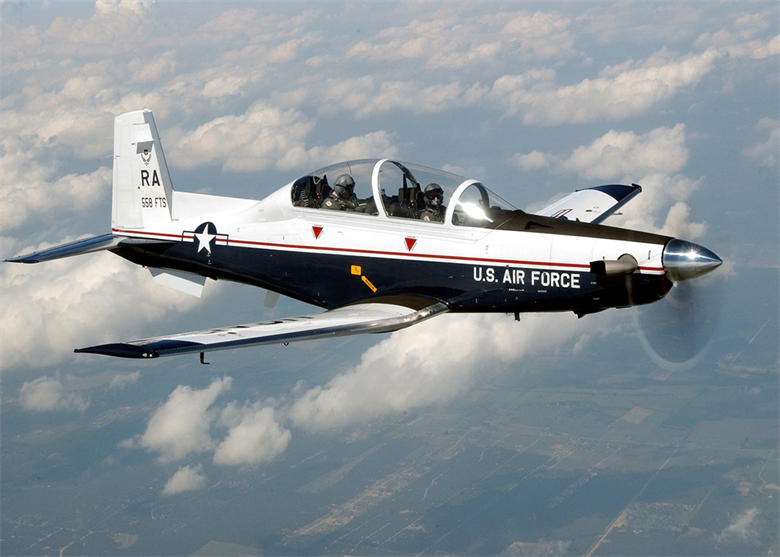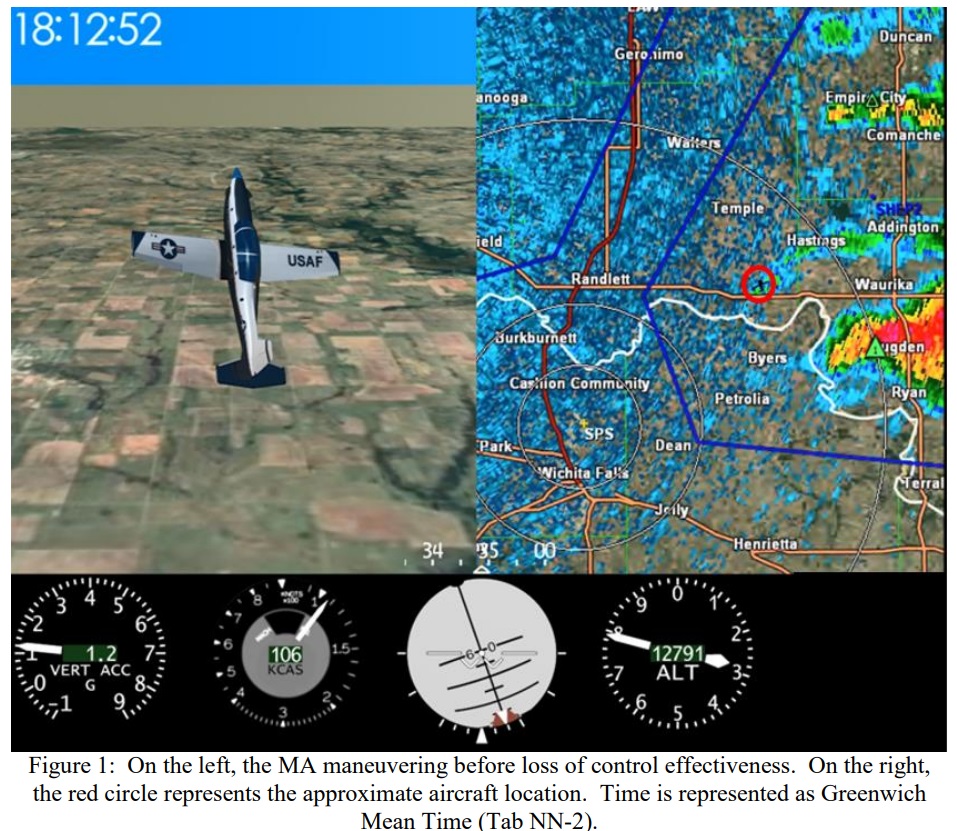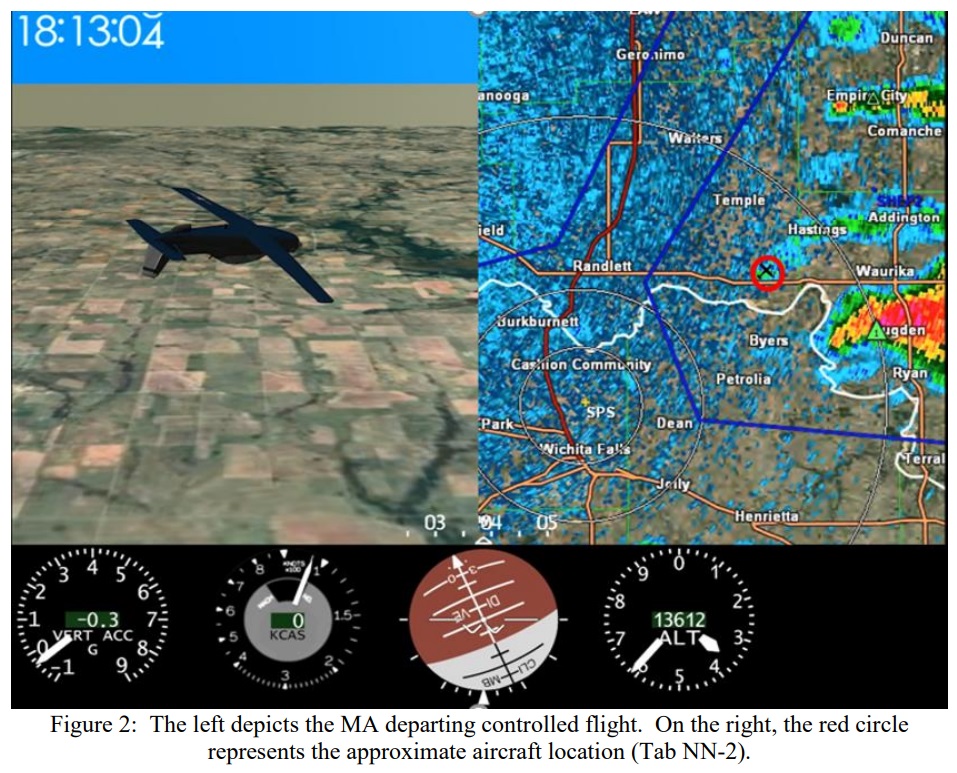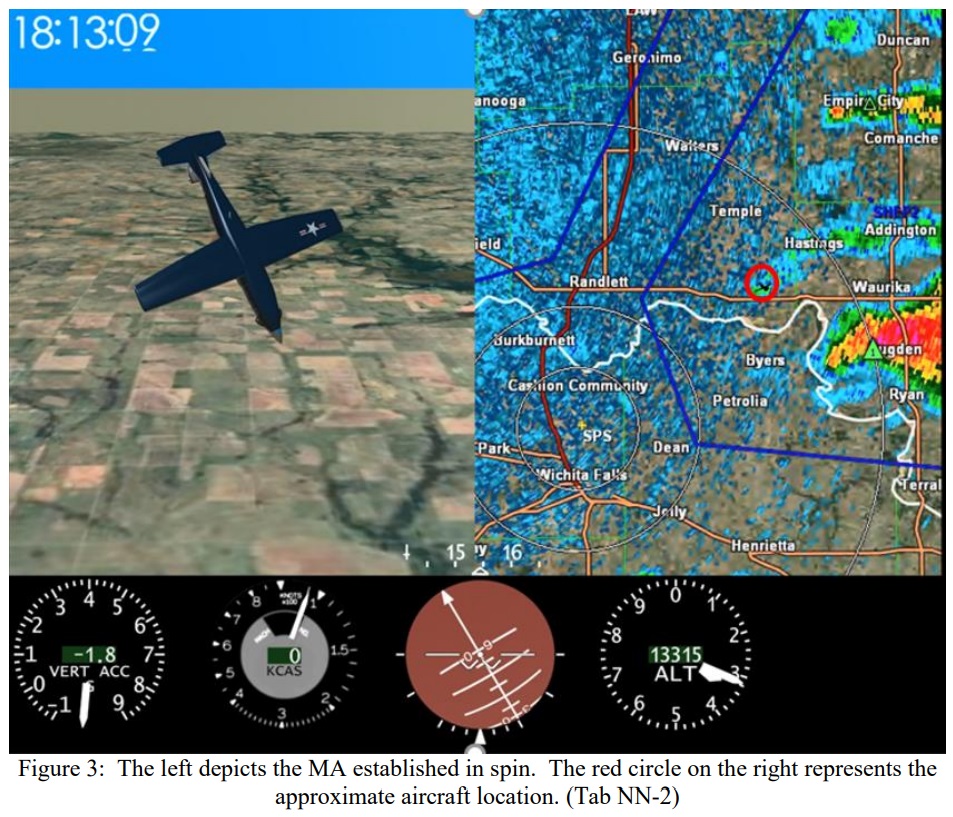USAF T-6A Texan II Lost in Inverted Stall
On 1 May 2019 US Air Force (USAF) Beechcraft T-6A Texan II 07-3890, crashed 21 miles NE of Sheppard Air Force Base (AFB), Texas. The crew safely ejected using Martin Baker Mk 16 ejection seats and suffered only minor injuries. The aircraft, valued at approximately $5.7 million, was destroyed.
The Accident Flight
On board were an instructor from 97th Flying Training Squadron (FTS) and a ‘student’ from 89 FTS (both part of the 80th Flying Training Wing). The instructor had 2,153.6 military flight hours, 795.7 hours in the T-6A. The ‘student’ had 4,846.6 total hours logged as a pilot in the Italian Air Force. They had been assigned as a T-6A instructor at Sheppard AFB from 2011-2013, flying 1,290.2 hours in the T-6A. They were regaining currency by undertaking Pilot Instructor Training (PIT).
The 89th FTS is comprised of 60 personnel from 13 NATO nations, and trains mores than 100 student pilots and 24 instructor pilots annually in support of Euro-NATO Joint Jet Pilot Training Program.
The USAF Accident Investigation Board (AIB) report explains that:
While setting up a training maneuver with building cloud formations, the Instructor flew the aircraft in an unintentional nose-high trajectory with decreasing airspeed. At 13:12:52L the aircraft passed through 12,800 feet MSL, 60º nose-high with airspeed decreasing below 100 knots.
In an attempt to regain airspeed, the instructor tried to lower the nose of the aircraft towards the horizon and penetrated the weather. Next, the instructor attempted to roll wings level while still in a [30º] nose-high attitude with insufficient airspeed and high-power setting. This resulted in a left torqueroll, placing the aircraft into a power-on, inverted spin while still in Instrument Meteorological Conditions (IMC). A left torque-roll occurs when aerodynamic forces are insufficient to overcome the rolling motion induced by the propeller.
The instructor recognized the inverted state of the aircraft but never completed the critical action of pulling the Power Control Lever (PCL) to IDLE. Maintaining the high power setting prolonged the state of the spin and pushed the aircraft into a steeper nose-low attitude.
Due to the disorienting nature of the inverted spin entry, coupled with IMC, unusual negative gravitational forces, and the aircraft’s propensity for pro-spin rudder, the instructor could not identify and input the appropriate controls for timely recovery. Furthermore, due to the negative G’s, the instructor’s distorted body position affected the view of the altimeter, which was partially obscured by the glare shield. This prevented the instructor from seeing the specific altitude displayed in the upper portion of the altimeter, but did allow recognition of the downward trend.
The crew ejected at 10,830 feet MSL as the aircraft continued to spin 60º nose-low with inconsistent airspeed indications
https://youtu.be/cIwEG7opxtg
USAF AIB Human Factor’s Analysis
The investigators applied the the DoD Human Factors Analysis and Classification System (DoD-HFACS) taxonomy based on the work of Wiegmann and Shappell. They identified following human factors:
- Fixation (PC102): This occurs when an individual is focusing all conscious attention on a limited number of environmental cues to the exclusion of others. “Post mishap, the instructor reported focusing attention over the right shoulder at the horizon”.
- Environmental Factors Affecting Vision (PE101): “During this attempted recovery, the aircraft entered the weather, lost outside visual references, and departed controlled flight”.
- Checklist Not Followed Correctly (AE102): “Both inverted spins and spins in IMC are prohibited maneuvers in the T-6A” and the instructor “did not pull the PCL back to IDLE, the first step in the memorized, critical-action Inadvertent Departure from Controlled Flight checklist”.
- Spatial Disorientation (PC508): This occurs when “an individual fails to accurately sense a position, motion, or attitude of the aircraft/vehicle/vessel or of oneself”. During setup to the manoeuvre, the instructor focused on the weather and did not crosscheck attitude with the aircraft’s instruments. “Upon entering the spin, the crew could not recognize turn-direction and roll rate. As documented in flight tests, power-on, inverted spins to the right are disorienting due to rapid roll and pitch oscillations.”
USAF AIB Conclusions
The Accident Investigation Board President found…
…that the cause of the mishap was the instructors fixation on the outside environment, not recognizing the nose-high attitude and slow airspeed, then failure to apply the memorized critical-action Inadvertent Departure from Controlled Flight Procedures checklist in a timely manner.
and
…the following two factors substantially contributed to the mishap: environmental conditions affecting vision and spatial disorientation.
Safety Resources
- MC-12W Loss of Control Orbiting Over Afghanistan: Lessons in Training and Urgent Operational Requirements
- USMC CH-53E Readiness Crisis and Mid Air Collision Catastrophe
- RCAF Production Pressures Compromised Culture
- Loss of RAF Nimrod MR2 XV230 and the Haddon-Cave Review
- C-130 Fireball Due to Modification Error
- AC-130J Prototype Written-Off After Flight Test LOC-I Overstress
- C-130J Control Restriction Accident, Jalalabad
- Korean T-50 Accident at Singapore Airshow
- ‘Procedural Drift’: Lynx CFIT in Afghanistan
- LOC-I Departure: AAIB Report on King Air 200 Accident
- Investigation into F-22A Take Off Accident Highlights a Cultural Issue
- USAF Engine Shop in “Disarray” with a “Method of the Madness”: F-16CM Engine Fire
- Inadequate Maintenance, An Engine Failure and Mishandling: Crash of a USAF WC-130H
- Inadequate Maintenance at a USAF Depot Featured in Fatal USMC KC-130T Accident
- USAF Parachutist Fatally Extracted Through Ventilation Door
- USAF T-38C Downed by Bird Strike
- Contaminated Oxygen on ‘Air Force One’ Poor standards at a Boeing maintenance facility resulted in contamination of two oxygen systems on a USAF Presidential VC-25 (B747).
- ‘Crazy’ KC-10 Boom Loss: Informal Maintenance Shift Handovers and Skipped Tasks







Recent Comments